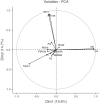Comprehensive autoantibody profiles in systemic sclerosis: Clinical cluster analysis
- PMID: 36685532
- PMCID: PMC9846214
- DOI: 10.3389/fimmu.2022.1045523
Comprehensive autoantibody profiles in systemic sclerosis: Clinical cluster analysis
Abstract
Background: Systemic sclerosis (SSc) belongs to the group of connective tissue diseases and is associated with the occurrence of disease-specific autoantibodies. Although it is still controversial whether these antibodies contribute to pathogenesis, there are new insights into the development of these specific antibodies and their possible pathophysiological properties. Interestingly, they are associated with specific clinical manifestations, but for some rarer antibodies this association is not fully clarified. The aim of this study is a comprehensive analysis of the serum autoantibody status in patients with SSc followed by correlation analyses of autoantibodies with the clinical course of the disease.
Methods: Serum from SSc patients was analyzed using a line blot (EUROLINE, EUROIMMUN AG) for SSc-related autoantibodies. Autoantibodies to centromere, Topo-1, antimitochondrial antibodies (AMA) M2 subunit, angiotensin II type 1 receptors (AT1R) and endothelin-1 type-A-receptors (ETAR) were also determined by ELISA. We formed immunological clusters and used principal components analysis (PCA) to assign specific clinical characteristics to these clusters.
Results: A total of 372 SSc patients were included. 95.3% of the patients were antinuclear antibody positive and in 333 patients at least one SSc specific antibody could be detected. Four immunological clusters could be found by PCA. Centromere, Topo-1 and RP3 all formed own clusters, which are associated with distinct clinical phenotypes. We found that patients with an inverted phenotype, such as limited cutaneous SSc patients within the Topo-1 cluster show an increased risk for interstital lung disease compared to ACA positive patients. Anti-AT1R and anti-ETAR autoantibodies were measured in 176 SSc patients; no association with SSc disease manifestation was found. SSc patients with AMA-M2 antibodies showed an increased risk of cardiovascular events.
Conclusion: In our in large cluster analysis, which included an extended autoantibody profile, we were able to show that serologic status of SSc patients provides important clues to disease manifestation, co-morbidities and complications. Line blot was a reliable technique to detect autoantibodies in SSc and detected rarer autoantibodies in 42% of our patients.
Keywords: autoantobodies; cluster analysis; primary biliary cholangitis (PBC); scleroderma; systemic sclerosis.
Copyright © 2023 Höppner, Tabeling, Casteleyn, Kedor, Windisch, Burmester, Huscher and Siegert.
Conflict of interest statement
CT received funding for research from Deutsche Gesellschaft für Pneumologie, Bayer HealthCare, Boehringer Ingelheim, and for lectures and advisory from Actelion Pharmaceuticals, Boehringer Ingelheim, GlaxoSmithKline, and for non-financial support from Actelion, ALK-Abelló, Bayer HealthCare, Boehringer Ingelheim and GlaxoSmithKline. The remaining authors declare that the research was conducted in the absence of any commercial or financial relationships that could be constructed as a potential conflict of interest.
Figures


References
-
- Walker UA, Tyndall A, Czirják L, Denton C, Farge-Bancel D, Kowal-Bielecka O, et al. . Clinical risk assessment of organ manifestations in systemic sclerosis: A report from the EULAR scleroderma trials and research group database. Ann Rheum Dis (2007) 66(6):754–63. doi: 10.1136/ard.2006.062901 - DOI - PMC - PubMed
Publication types
MeSH terms
Substances
LinkOut - more resources
Full Text Sources
Medical

